The Naked Scientists hit Hollywood for a special show all the way from California. We meet the cream of Californian scientists from the University of California at LA and at San Diego to find out why designing ocean-going robots is like giving birth; what some dust-covered 50-year old experiments can reveal about the origins of life, and why your friends and even their friends, can affect your weight. We discover the work of the Population Institute, who use radio soap-operas to inspire better family planning. Plus, we find out why plants get jetlag, how nanotechnology can help foil terrorist attacks and we visit the Naked Cafe to discuss the Big Bang over coffee. In Kitchen Science, Ben and Carlos Camara generate x-rays from sticky tape!
In this episode
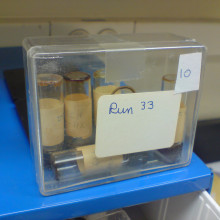
09:04 - The Origin of Life
The Origin of Life
with Jeffrey Bada, Scripps Institution of Oceanography University of California, San Diego
Jeff - In the early part of the 20th century several people had proposed that organic compounds were made directly on the Earth and this formed a prebiotic soup. Eventually out of this maturing prebiotic soup somehow life evolved. Up to the time of Urey's thinking on this no one had succeeded in making or demonstrating how you could make organic compounds in a simulated Earth environment. Urey's idea that you had a different atmosphere was a new one. He presented a lecture at the University of Chicago in 1952 and one of the people in the audience was a young graduate student, Stanley Miller, who was intrigued by this experiment. Afterwards he went to Urey and suggested that he do this experiment for his PhD thesis.
Chris - What did he do?
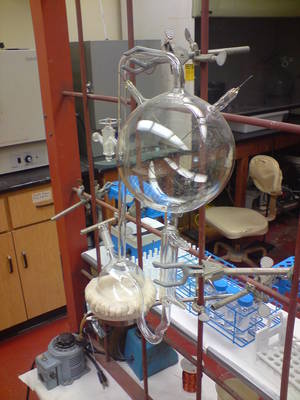 Jeff - Well, the first thing that Urey said was no, it was too risky an experiment for a graduate student to carry out. Stanley persevered and the first thing they had to consider is what kind of apparatus or how you test this idea. They decided to come up with the apparatus we see in front of you which is designed to mimic the ocean-atmosphere interaction on the early Earth. You have one flask in which you have water and this water is boiled. It goes up and circulates into this other flask which is full of gas which is considered to be a model of the atmosphere.
Jeff - Well, the first thing that Urey said was no, it was too risky an experiment for a graduate student to carry out. Stanley persevered and the first thing they had to consider is what kind of apparatus or how you test this idea. They decided to come up with the apparatus we see in front of you which is designed to mimic the ocean-atmosphere interaction on the early Earth. You have one flask in which you have water and this water is boiled. It goes up and circulates into this other flask which is full of gas which is considered to be a model of the atmosphere.
Chris - That would have contained some hydrogen, some ammonia and some methane to simulate the environment of the early Earth?
Jeff - That's correct. You'd have methane and ammonia in this flask here which represents the atmosphere. Then you have these two electrodes. These electrodes are where you can apply this spark which would simulate lightning.
Chris - How would he have actually made the sparks then?
Jeff - To make a spark he would use this thing here called a Tesla coil which is something very similar to what you see in Frankenstein movies which generates an electric discharge. I'll plug this in right now and you can hear this. So now you take this Tesla coil and you apply it directly to the electrodes. That generates a spark inside the flask where the gases are. This is the way energy is injected into this system.
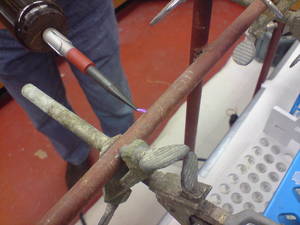 Chris - When he sparked a mixture like that what did he find?
Chris - When he sparked a mixture like that what did he find?
Jeff - He let the spark run and he boiled the water to last for about a week. One of the things he noticed right away is this whole thing turned brown. It got really goopy. One of the remarkable things was that it contained a number of amino acids. Amino acids are the compounds that make up proteins in all living organisms. They're considered to be essential molecules for life. In this simple experiment he'd taken methane, ammonium and hydrogen. In the presence of water a spark made these proteins. It was a remarkable experiment. What's amazing about this is that he actually saved aliquots or portions of this water solution from his original experiment. We didn't realise this 'til earlier this year when we found some old boxes of his in my laboratory. Inside were these little phials that were clearly marked to show that they came from these early 1953 experiments.
Chris - Did you say, let's see what the power of modern chemistry can tell us about what's in these flasks?
Jeff - I was extremely interested in what these might tell us today using the modern analytical tools we have at our disposal. I had two motivations and Stanley died last year. I wanted to go back and revisit and see what the diversity of compounds actually was that he may have missed. More importantly, we realised we also had samples from a couple of other variants of the apparatus that he'd not really adequately investigated at all. He'd done some preliminary analysis but had not done a very rigorous analysis of the products from those apparatus. I was really intrigued by those: especially one of them which we thought might represent an early volcanic system on the earth.
Chris - When you went back and analysed the samples he'd stored what did you find?
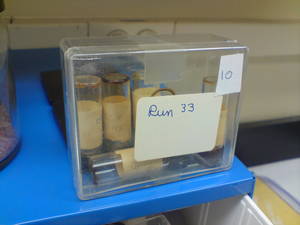 Jeff - What's interesting is that the ones from what we call the classic apparatus like you see in front of us here: we pretty much showed that the major amino acids were just like he'd found before. Then there were a whole number of lesser amino acids. We could expand the inventory of compounds that he had actually made. We more or less tripled the number that he'd found.
Jeff - What's interesting is that the ones from what we call the classic apparatus like you see in front of us here: we pretty much showed that the major amino acids were just like he'd found before. Then there were a whole number of lesser amino acids. We could expand the inventory of compounds that he had actually made. We more or less tripled the number that he'd found.
Chris - Putting all that together, what does this tell us about the early Earth? Apart from the fact that Stanley Miller could well have been right. What does this tell us about where the building blocks of life probably came from and the environment on the early Earth that gave rise to them?
Jeff - Today many geochemists think that the atmosphere as a whole did not contain methane and hydrogen like Stanley used in his original experiment. As a result you were left with the puzzle again: where did the raw materials necessary for the origin of life come from? The variant of this that he had only partly tested (and we re-investigated it) show that if you have a localised environment such as an island volcanic system on the early Earth and you were releasing volcanic gases in that they'd be immediately subjected to volcanic lightning and these compounds would have been synthesised in a localised environment rather than a global environment. You can imagine early Earth being covered by hundred of these little volcanic islands, acting as little prebiotic factories. All of them would be contributing to the prebiotic soup. I think this demonstrates that the idea of making compounds directly on the early Earth via processes that Miller imagines in 1953 is still very much relevant today.

18:01 - Do Your Friends Make you Fat?
Do Your Friends Make you Fat?
with James Fowler, UCSD
James - I'm really interested in all of human nature. One of the aspects that I'm interested in is social networks. My colleague Nicholas Christakis and I have looked at the Framingham Heart Study in which we've mapped the full social network of 5000 people.
Chris - When you say social network, what does that actually mean?
 James - That means friendships that means any kind of social relationship that you might have with a person. Some of these are family relationships like your parent, a sibling, your child. Some of these are relationships with people at work: your co-workers and also relationships with people you're nearby: your neighbours, next door neighbours and so on.
James - That means friendships that means any kind of social relationship that you might have with a person. Some of these are family relationships like your parent, a sibling, your child. Some of these are relationships with people at work: your co-workers and also relationships with people you're nearby: your neighbours, next door neighbours and so on.
Chris - How do you dissect apart these social networks so you can work out who's friends with whom?
James - We got lucky with Framingham. In order to keep people coming back year after year, this is a very long-standing epidemiological study, we keep people coming back year after year we have detailed administrative records: not just on their family members but they also ask them to name a close friend who'll know where you are 2-4 years from now. We got a grant to actually turn all of that into electronic data so we have all the connections between one another in the study.
Chris - How did you interrogate that data and what did you find?
James - So we matched a lot of the data about health attributes to the social network and the very first place we looked was obesity. The reason why we started there is because that's a very easy thing to measure. Every time someone comes to the doctor every 2-4 years they get measured for height and they get on the scales. It's a very objective, easily measured attribute. We were very interested to see if something unexpected could flow through these social networks. What we found was that if your friend becomes obese it increases the likelihood that you'll become obese. This was true for friends, it was true for spouses and also for siblings.
Chris - I can understand this for family as people tend to eat together and therefore they tend to eat the same things in the same amounts. How do you explain friends?
James - Well, one other interesting finding that helps to explain it is that friends who lived hundreds of miles away appeared to have just as big an impact as friends who lived next door. One possibility if you found something like this would be that what's going on is you are eating together, you're drinking together and you're exercising together. The fact that the friends who lived so far away also had an effect means that what we thing is happening is the spread of social norms. This is the idea that meeting your friend once a year at Thanksgiving or something like that and you think, 'Hey, this person's put on weight - it's ok if I put on a little bit of weight.' Maybe they start talking about some exercise programme and you think maybe I should get to the gym more often and it changes your behaviour.
Chris - Someone wrote to me once and said that she pursues a relative diet where she brings in big bags of donuts and cakes for everyone in the office because relative to them, when they eat them all, she stays slim.
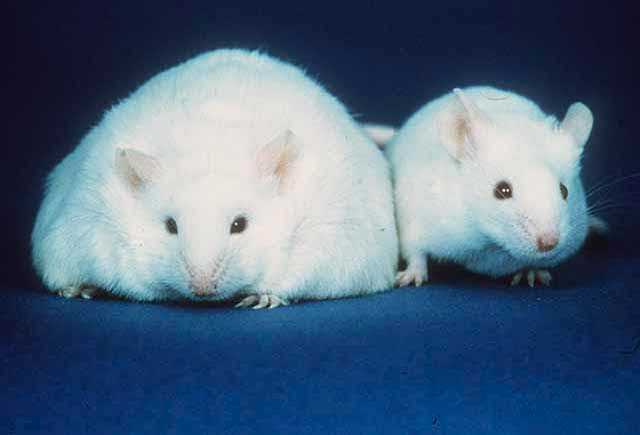 James - That's right! And some of the more amusing commentaries to our work appeared in cartoons. One of them was a Cathy cartoon in which the three friends were talking very nervously about the study and saying: 'This doesn't mean we have to stop being friends with each other.' Then when the waiter comes over they ask what they'll have to eat. Each points to the other saying: 'She'll have a salad and water.' I think there was this idea that people were worried from the study that people would take away some negative points from this. That you should get rid of your friends who are overweight. In fact the data suggests the opposite, that you only spread these kinds of behaviours through close social contacts: only close social contact actually makes us healthier. Really the best thing you can do is take control of your own behaviour or alternatively try to help your friends in taking control of their behaviour.
James - That's right! And some of the more amusing commentaries to our work appeared in cartoons. One of them was a Cathy cartoon in which the three friends were talking very nervously about the study and saying: 'This doesn't mean we have to stop being friends with each other.' Then when the waiter comes over they ask what they'll have to eat. Each points to the other saying: 'She'll have a salad and water.' I think there was this idea that people were worried from the study that people would take away some negative points from this. That you should get rid of your friends who are overweight. In fact the data suggests the opposite, that you only spread these kinds of behaviours through close social contacts: only close social contact actually makes us healthier. Really the best thing you can do is take control of your own behaviour or alternatively try to help your friends in taking control of their behaviour.
Chris - If it is a sort of social factor and the spreading of social norms in the way in which you say, if you look at things other than obesity do you see the same pattern emerging?
James - We do see them emerging with a number of other things that we do study. We had a follow-up study on smoking behaviour. There again we saw just the same that if your friends are smoking it increases the likelihood that you'll end up smoking. One interesting thing that we're starting to see in a variety of these studies is that it's not just your friend that matters, it's your friend's friend and even your friend's friend's friend. Although it's people that we don't know and have never met we can change their behaviour and it's going to ripple through the network and have an effect on us.
Chris - Do you think you could get sued one day for being fat and letting it rub off on your friends?
James - It's funny you say that. There's a programme in the United States called Boston Legal. Shortly after our paper came out last year this was a plotline that one of the main characters who's this sleazy character played by William Shatner, you know the old Captain Kirk. He fired one of his secretaries because she was overweight. She came back and sued him for firing her. His argument was well, here are these guys from Harvard, they've told you that this person's going to make me fat. I have a right to fire her for that reason.
Chris - The outcome?
James - I don't know because I didn't watch the programme! I don't know if she was found guilty. I do know that it raises this point that seemed to be in the press a lot when people were discussing our work which was, what do you do with this information? Unfortunately a lot of people said here are new criteria for getting rid of friends. I hope no one takes any of our research to mean that. Typically what we find is that every friend makes us better off.
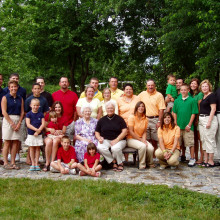
23:50 - The Population Institute
The Population Institute
with Bill Ryerson
Bill - Population institute works with leadership groups to educate them and involve the in population issues. Population in many ways is the unmentioned elephant in the living room of global sustainability issues. The institute is there to remind people that 6.7 billion people growing to 9.2 billion people in a short 50 years is a huge factor in all of the issues that the planet is facing.
Ben - How big really is the elephant? How fast is the world's population expanding?
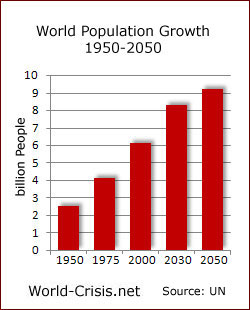 Bill - There are many ways to answer that question. You can say one per cent. People say one per cent doesn't sound very much, I earn more than that on my money market funds. On the other hand 1 per cent means the population's doubling every 70 years. When you have such a huge population: now four times what it was a century ago and it doubles in just 70 years the impact is huge in terms of planetary resources. Population is a driver of almost everything else with regard to both environmental and food security and international security issues.
Bill - There are many ways to answer that question. You can say one per cent. People say one per cent doesn't sound very much, I earn more than that on my money market funds. On the other hand 1 per cent means the population's doubling every 70 years. When you have such a huge population: now four times what it was a century ago and it doubles in just 70 years the impact is huge in terms of planetary resources. Population is a driver of almost everything else with regard to both environmental and food security and international security issues.
Ben - What can be done about the rising rate of growing populations?
Bill - One of the key barriers to solving the population problem has to do with perceptions by people and information or misinformation that they may have. For example, among the roughly 130 million couples who don't want to have additional children and are not using contraception maybe 2% give lack of access to services as their reason for non-use of contraception. The primary reasons are they've heard it's dangerous, they've no idea that having 10 children starting at age 15 is far more dangerous. They also cite male opposition. They think their husbands or partners oppose. They think their religion is opposed. 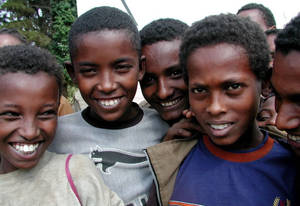 It may come as a surprise to listeners but there's no religion that is opposed to planning one's family or to planning one's life. No religion is telling their followers to have more children than they can afford to feed or care for. Religious opposition is something that people mistakenly believe is a factor and also fatalism. Many women, when asked how many children they want, say, 'I want no more than I currently have because I can't feed the ones I have.' Then they're asked do you understand that because you're not using family planning that you could become pregnant and have another child. Then they'll say, 'that'll be ok because if that's god's will then that's why I'm here.' It's as if god, at the beginning of the universe, has decided how many children they're going to have. Changing those cultural and informational barriers to family planning use is critically important. How do we do that? We're role modelling small family norms, use of family planning, elevation of women's status, daughter education and similar measures through long-running, serialised melodramas. Let's call them soap operas for social change. These programmes, which will go on for months and years, can create characters who
It may come as a surprise to listeners but there's no religion that is opposed to planning one's family or to planning one's life. No religion is telling their followers to have more children than they can afford to feed or care for. Religious opposition is something that people mistakenly believe is a factor and also fatalism. Many women, when asked how many children they want, say, 'I want no more than I currently have because I can't feed the ones I have.' Then they're asked do you understand that because you're not using family planning that you could become pregnant and have another child. Then they'll say, 'that'll be ok because if that's god's will then that's why I'm here.' It's as if god, at the beginning of the universe, has decided how many children they're going to have. Changing those cultural and informational barriers to family planning use is critically important. How do we do that? We're role modelling small family norms, use of family planning, elevation of women's status, daughter education and similar measures through long-running, serialised melodramas. Let's call them soap operas for social change. These programmes, which will go on for months and years, can create characters who 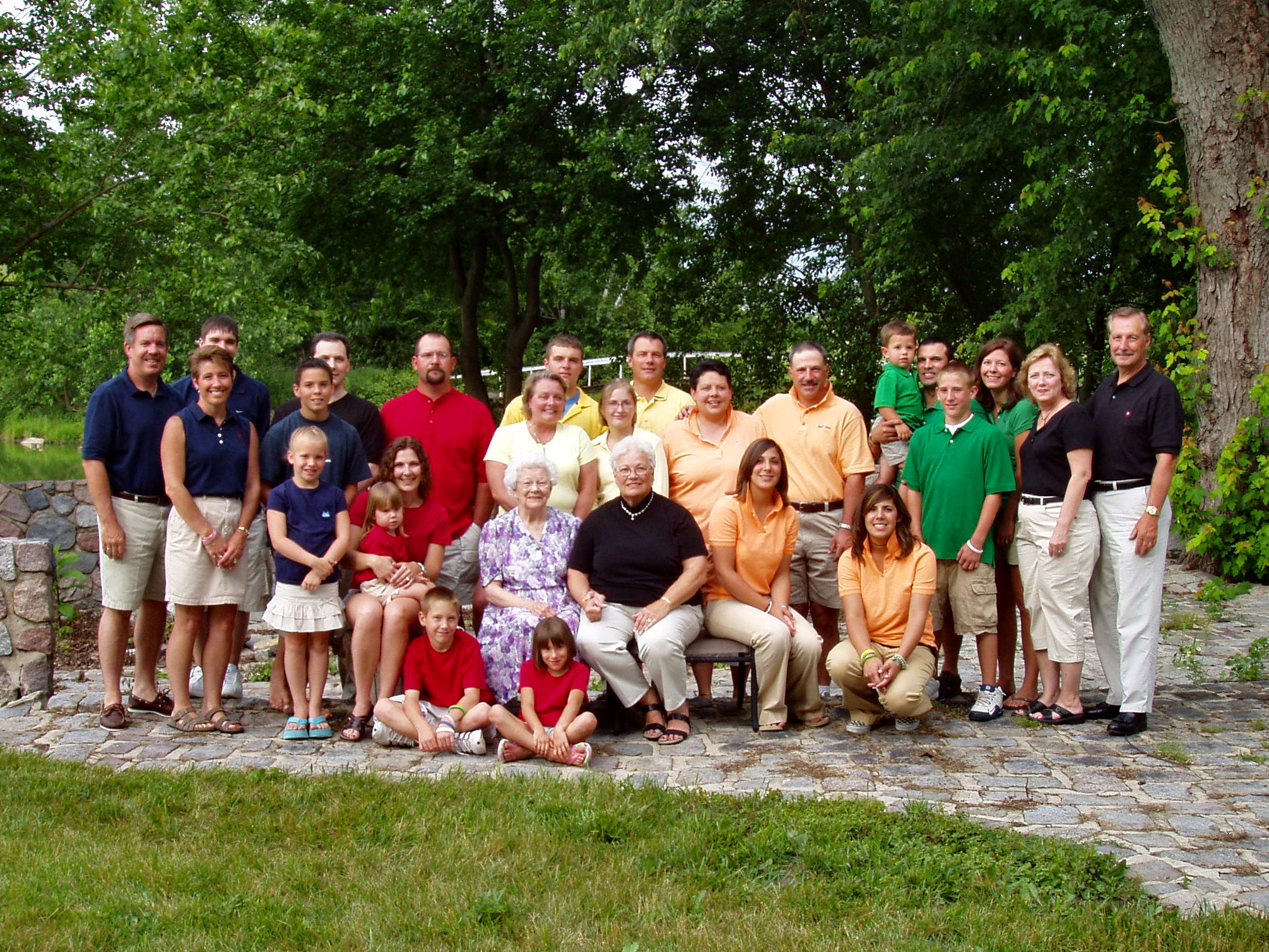 ultimately find their way to a new set of values, new behaviours. They realise in front of massive audiences the benefits of those behaviours and they change social norms. Among the roughly 50% of married women in Ethiopia who are listening to one of our serial dramas there was a tripling of family planning use. Similarly we measured a quadrupling of HIV testing in male listeners and a tripling among female listeners. So these programmes can be very influential, particularly if they're well-written, if they attract huge audiences episode after episode and follow the evolution of these characters, see the benefits for these characters and decide without ever being told what to do that indeed this is a strategy they should try.
ultimately find their way to a new set of values, new behaviours. They realise in front of massive audiences the benefits of those behaviours and they change social norms. Among the roughly 50% of married women in Ethiopia who are listening to one of our serial dramas there was a tripling of family planning use. Similarly we measured a quadrupling of HIV testing in male listeners and a tripling among female listeners. So these programmes can be very influential, particularly if they're well-written, if they attract huge audiences episode after episode and follow the evolution of these characters, see the benefits for these characters and decide without ever being told what to do that indeed this is a strategy they should try.

28:39 - The Global Media Awards
The Global Media Awards
with Jenny Wetter, Population Institute
Jenny - The global media awards are an opportunity for the population institute to congratulate and encourage population and population-related issues such as how it affects environment, security, food availability and then this whole slew of issues around population. It gives us an opportunity to look at various outlets including film, newspaper, radio and hopefully encourage more media outlets to do more work in this area.
 |
| The Premiership trophy - Not quite a Global Media Award... © Jameboy |
Ben - Media is quite a big world. As it's global media you have a huge range of people to look at. The winners were not only from the States and the UK but also from the Philippines, as far away as that. How do you actually choose in the first place who to look at, even for a shortlist?
Jenny - We send out a call for entries around the world. We go to various outlets. We just kind of put it out there to whoever is going to answer it. We had entries from most of the continents. We had several entries from Africa, the Philippines, in Asia and Europe. I don't think we had any from South America this year but it's a great opportunity to highlight people doing things all over the world.
Ben - How do you choose who will win?
Jenny - We brought together all of our entries and we had seven different judges. Each judge was responsible for 2-3 different categories. We had two judges per category. They rate all the entries that they had in each category. The two judges would then confer on their list of ranked entries and if they agreed then they were done. If they didn't agree then they would talk about why they favoured this one over that one. Then the judges ultimately came to a decision.
Ben - How many nominations did you have? How many did you start with?
Jenny - This year we had 161 entries from most continents around the world. It was great.
Ben - Although you know the geographical remit is huge, it's a global awards system, did people have to specifically work on population issues or do you reward the efforts of people who look at things in a broad way and just happen to focus on population as one particular blog post or one particular issue?
Jenny - I think The Naked Scientists was a great example of someone who doesn't necessarily focus on population issues but looks at science issues as a whole. While some of their talks may talk about population you don't need to focus solely on population. It's great to bring in these audiences that maybe aren't as familiar with population issues, to be more familiar with them.
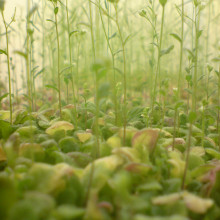
31:23 - Do plants have body clocks?
Do plants have body clocks?
with Steve Kay, UCSD
Steve - What our lab principally studies is biological rhythms in plants. People understand biological rhythms or circadian rhythms really from the jetlag they experience such as the BBC team might be feeling coming to San Diego. Plants also have these 24 hour rhythms but of course, they don't a sleep-wake cycle like humans have. What plants do is control their metabolism, their photosynthesis rates and what we've discovered recently is plants actually grow rhythmically.
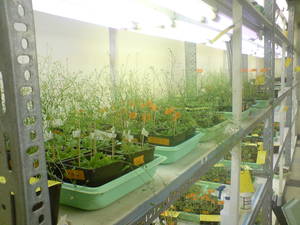 Chris - When does a plant do most of its growth? Most people presume plants need sunlight to grow. They're therefore going to grow during the day and go to sleep at night.
Chris - When does a plant do most of its growth? Most people presume plants need sunlight to grow. They're therefore going to grow during the day and go to sleep at night.
Steve - That's quite right. Plants do need sunlight for energy through photosynthesis. What we and others have discovered in recent years is that the vast majority of plants on this planet actually grow at night.
Chris - Why?
Steve - We're not exactly sure why. It could potentially be that DNA synthesis, which has to happen every time you divide plant cells and grow, perhaps DNA synthesis needs to occur in the dark to protect it from damage. It could be something like this.
Chris - Presumably if you understand how plants grow you can grow bigger ones?
Steve - Well absolutely. There are lots of numbers in science but the two numbers that worry me those most are 6.5 billion (the number of people there are now) and 9 billion (the likely number of people in 2050). We're going to be facing a serious food crisis so what we really want to understand is what makes plants tick? What are the processes that make plants grow better, compete in their environment better, use nutrients more efficiently? What we're discovering is that the plant's biological clock is at the centre of all these processes, regulating plant growth.
Chris - How do plants detect time? We know humans do it well. We know there are clusters of nerve cells in the brain that have this sort of genetic domino effect which keeps time. How do plants do it?
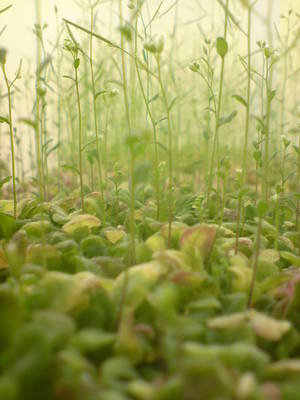 Steve - Plants have a localised clock like we do in our brain. Plants have distributed their clock into every cell. For a human, our clock is reset by light entering our eyes. Although this may sound a little creepy there are eyes in every cell of the plant. There are proteins that transmit light to the plant and reset the plant every day.
Steve - Plants have a localised clock like we do in our brain. Plants have distributed their clock into every cell. For a human, our clock is reset by light entering our eyes. Although this may sound a little creepy there are eyes in every cell of the plant. There are proteins that transmit light to the plant and reset the plant every day.
Chris - But plants would be interesting because the ones you've got on your shelf here, they have flowers. This means certain bits of this plant know it's now time for me to make a flower. How does the plant tell one bit of the plant 'stop growing leaves and start growing modified leaves called flowers'?
Steve - It's a fascinating story. Plants use their leaves to tell daily time and to measure the amount of light that's around. They combine the measurement of dawn and dusk with an internal timekeeper to actually discriminate day length. These plants that are sitting next to us can actually tell when the days are getting shorter because they're short-day plants. That will induce flowering. Other plants are long-day plants as they measure the days getting longer they send a signal to the tip of the plant and they start making flowers.
Chris - Does this mean then that plants from one part of the world which are well-adapted to a certain day length, because they've evolved there - if you take them to another latitude - will grow less well?
Steve - Yes, absolutely. If you take plants from one clime or latitude and bring them to another then they're not going to be able to correctly interpret the day length signals and they're going to beless well adapted to that niche. What we really want to understand is, how can we begin to take advantage of what we're learning about plant growth mechanisms? Really to have an impact on agriculture.
Chris - What about climate change though? If we assume that the environment's going to change and therefore plants may have to grow in different environments and different latitudes in future but they're unable to reset their clocks. How are they going to compensate? We think climate change is going to happen more quickly than these plants have evolved in the first place.
Steve - Climate change is going to be a significant challenge both for natural ecosystems as well as for man-made agricultural biologies. What we need to do is understand the basic mechanisms by which plants adapt to stress, adapt to light levels, adapt to temperature, measure day length and essentially what we're going to be able to do from an agricultural perspective is to have tailor-made crops that we'll be able to adapt to the new types of environments produced by climate change.
Chris - How easy is that to do?
Steve - It's very hard. It's going to require, I think, a lot more effort in plant biology in general. Here in the United States, for example, we spend less than one per cent of the federal research budget on plant science versus biomedicine.
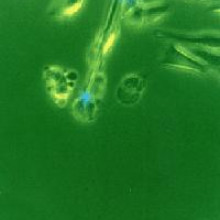
36:38 - Nano-Sensors
Nano-Sensors
with Michael Sailor, UCSD
Michael - We work on nano materials: primarily silicon or iron oxide-based materials. These are devices or materials that are so small they often can't been seen by the human eye or they just look like little specs. They have structures inside them that are built to the nano scale.
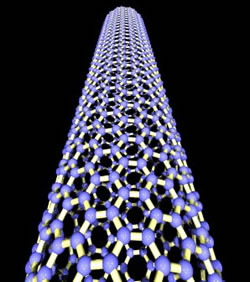 Ben - When we say nanoscale we know this is quite a cliché now but how big would these be in comparison to a human hair?
Ben - When we say nanoscale we know this is quite a cliché now but how big would these be in comparison to a human hair?
Michael - About a thousand times smaller than a human hair. The real challenge of nanotechnology is to build a very sophisticated structure in a small space. The reason you want to make the small space for environmental sensing is because those smaller spaces allow you to do things you can't do with bigger things. For example, we make sensors that can go on the body that can be small enough to fit on a needle. For environmental sensing you really don't need something that small and typically the materials that we work with at the environmental sensing area are large enough to see, maybe the size of a coin. They contain a nano structure. For example, we make these chips that have very small nano pores in them. These very small pores kind of suck up molecules very effectively. It's a phenomenon known as microcapillary condensation. If you have a very small pore, typically on the order of about a nanometre the vapours will spontaneously condense in those pores. It's a means of concentrating the gas that you're trying to sense.
Ben - Once you have been able to concentrate it how can you tell what you have there?
Michael - These are little silicon-based chips. Each one of these is about the size of a coin and you can see that they have a very pretty colour to them: intense green-blue or red colours. The colours derive from a nanostructure. What's more is that colour will change. I've got a little bottle of ethanol here. If I put a drop on this chip you'll see the colour will change from green to red.
Ben - It has immediately changed. This is just what looks like a glass microscope slide but it immediately changed in response to ethanol. Is it possible to get rid of the ethanol and use that slide again?
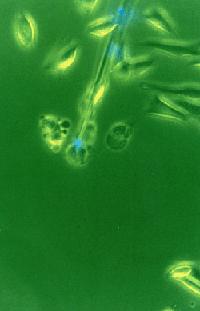
Ben - And it gives you an immediate answer as well. It tells you immediately the ethanol's present. In fact the ethanol must have evaporated by now because that's gone back to being a vivid green. What sort of limitations do we have? What can we actually use these sensors to detect?
Michael - We do a lot of work in biological sensing and chemical sensing. What tricks can you play with this nano structure to cause the colour to change when it only sees something like sarin gas? That's the gas used in the Tokyo subway bombings: a kind of terrorist weapon of the day. So how do you detect a nerve agent or how do you detect whether it's anthrax or it's an Ebola virus? What you need to use is some kind of chemistry or biochemistry to get you that specificity. For example, in the case of these chips to make a biosensor out of them one of the common tricks we'll play is we'll place an antibody inside the pores. This antibody may be very specific for certain kinds of molecules. We've got a system where we're looking for cholera toxin. Where we can detect cholera in drinking water based on putting an antibody in the pores that specifically binds just to that toxin and to nothing else. If we're looking for gas space molecules we play other tricks. For example the sarin detector that I just mentioned to detect that kind of chemical we place a specific catalyst in the pores, a copper-based catalyst, that will react specifically with the sarin and create products that react very uniquely with the structure and cause a colour change that we can detect.
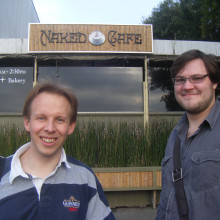
41:37 - The Birth of the Universe, over coffee
The Birth of the Universe, over coffee
with Hans Paar, UCSD
Hans - We are pretty sure that the universe began with a big explosion of space. The evidence as we know and see around all confirm that this started what we call a Big Bang.
Chris - When, roughly, did that happen?
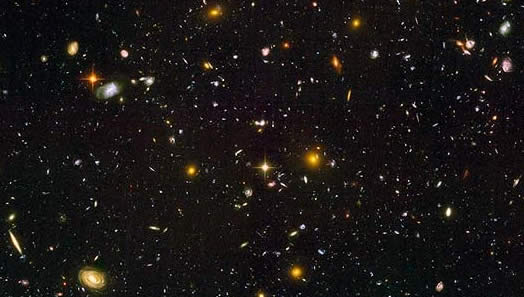 Hans - We know quite precisely when that happened because we can use the laws of physics to extrapolate from the present condition back to the beginning. It is approximately 13.6 billion years. That is a billion with a 'b'.
Hans - We know quite precisely when that happened because we can use the laws of physics to extrapolate from the present condition back to the beginning. It is approximately 13.6 billion years. That is a billion with a 'b'.
Chris - So, ever since then we think the universe has been expanding outwards. Does that mean then that you could notionally wind time back and find the point where the universe began?
Hans - That's an interesting thought and in fact that's how we calculate the age of the universe: by running the movie backwards, so to speak. One of the principles of the cosmological theory that describes the universe's early beginnings is there is no space where the universe began. To put it another way, there's no location where you can point to and say 'here's where it began.' It began everywhere at the same time. That's a very hard notion to get a hold of. Nevertheless, we firmly believe that this is true.
Chris - So the universe begins at one very powerful but very tiny point and suddenly something happens and it begins to expand. Does everything happen uniformly after that?
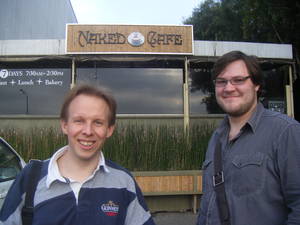 Hans - The expansion happened suddenly and it didn't happen uniformly. We think that in the very early beginning of the expansion there was an era which we call inflation where the universe expanded extremely rapidly. The velocities exceeded the speed of light by many, many factors. After about a very short time the universe resumed a normal expansion as we observe today.
Hans - The expansion happened suddenly and it didn't happen uniformly. We think that in the very early beginning of the expansion there was an era which we call inflation where the universe expanded extremely rapidly. The velocities exceeded the speed of light by many, many factors. After about a very short time the universe resumed a normal expansion as we observe today.
Chris - How would we get to the bottom of why there would have been those two phases? When there's a sudden burst of energy one would assume that things would just expand. Why would it behave in this interesting way?
Hans - This is completely unknown at the moment. There are speculations but we have no real evidence and I hope to further the field by eliminating at least some of the hypothesis about inflation by my experiment.
Chris - What are you going to do?
Hans - We have obtained funding, my colleagues and myself, which is dedicated to observing the radiation that was emitted during inflationary era. We will very carefully study the properties of that radiation, in particular something called polarisation. The polarisation is supposed to carry the imprint of the inflationary era with it.
Chris - So you're looking at radiation left over from the Big Bang. This is cosmic background radiation that you're going to study. Written in to that is the fingerprint of what happened in the early universe. How would you get that out of the cosmic background radiation then?
Hans - This is by studying the polarisation of the light. Polarisation of light is something everyone is familiar with because we all have Polaroid sunglasses and we have all been on the beach at one time or another in our lives. If you look at the water's surface with your Polaroid glasses and rotate them you will see dark and light areas. This is because the Polaroid sunglasses let through Polaroid light only polarised in one direction. Our telescope is just like that except it has got sunglasses that are ten feet, three metres in diameter. We catch the radiation with a very big dish and we measure the polarisation by essentially doing the same thing I just described with the small sunglasses.
Chris - What will you be looking for that will tell you whether or not this theory of sudden inflation and then a slower inflation is right or not?
Hans - What we'll be looking for is the polarisation itself. If the polarisation is found then we can be sure that inflation did happen. It's kind of a negative confirmation. If you don't see it we know nothing. If we do see it, we do see the polarisation then we are pretty sure inflation happened.
Chris - It sounds to me like the large hadron collider, the most expensive experiment in the history of physics. If we don't see anything it doesn't actually prove anything. If you do detect polarisation it still doesn't tell you why it happened. Have you got any theories as to why it could have happened?
Hans - That's entirely correct. When we measure the polarisation we will know it did happen very likely. We will not really know why it happened yet. More experimentation will be needed to find that out.
Chris - How will you solve that one?
Hans - I don't know. This is something that we haven't thought about very much yet because we first need to establish that inflation did happen before we worry about why it happened. Perhaps we will find out it didn't happen!
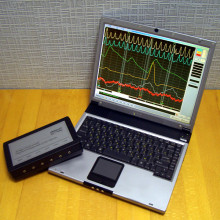
47:12 - Could some people pass a lie detector?
Could some people pass a lie detector?
We put this to Jim O'Shea, Intelligent Systems Group, Manchester Metropolitan University:
Old-fashioned lie detectors like the polygraph only detect stress. If the lack of remorse meant that the interviewees had reduced stress levels that would help them pass. Our lie detector, Silent Talker, makes its judgement on non-verbal behaviour: crudely what people call body language. Silent Talker can detect stress but lying involves other factors. We can only juggle a certain number of mental variables at once while we're thinking. If we've got to try and maintain a whole load of different factors about an imaginary story it's very difficult to do all the mental processing to keep that consistent. That's what's known as having a high cognitive load which affects non-verbal behaviour. Also duping delight occurs when liars get a kick out of getting a lie across successfully and again this affects non-verbal behaviour. In one of our own experiments on the general population we taught silent talk to recognise guilty feelings the participants felt while they were lying. When we added this information to the general lie detection we got more accurate classifications. In another independent study conducted by a different university using Silent Talker it was found that Silent Talker was effective at detecting lies told by psychopaths in interviews. So there we have it: evidence that remorse is a factor in the general population but also evidence that in the case of one disorder it's not the only factor.










Comments
Add a comment